-

新人教版高中英语选修2Unit 4 Learning about Language教学设计
This section guides students to pay attention to the typical context of vocabulary use, helps students accumulate vocabulary around the key vocabulary of this unit, and uses the learned words and word chunks in different contexts to deeply understand their meaning and usage, so as to achieve the purpose of review and consolidation.The teaching design activities aim to guide students to pay attention to the typical context in which the target vocabulary is used, as well as the common vocabulary used in collocation, so that students can complete the sentence with correct words. In terms of vocabulary learning strategies, this unit focuses on cultivating students' ability to pay attention to collocation of words and to use word blocks to express meaning.For vocabulary learning, it is not enough just to know the meaning of a single word, but the most important thing is to master the common collocations of words, namely word blocks.Teachers should timely guide students to summarize common vocabulary collocation, such as verb and noun collocation, verb and preposition collocation, preposition and noun collocation, and so on.1. Guide students to understand and consolidate the meaning and usage of the vocabulary in the context, 2. Guide the students to use the unit topic vocabulary in a richer context3. Let the students sort out and accumulate the accumulated vocabulary, establishes the semantic connection between the vocabulary,4. Enable students to understand and master the vocabulary more effectivelyGuiding the Ss to use unit topic words and the sentence patterns in a richer context.

新人教版高中英语选修2Unit 4 Reading for writing教学设计
假定你是英国的Jack,打算来中国旅行,请你给你的中国笔友李华写一封信,要点如下:1.你的旅行计划:北京→泰山→杭州;2.征求建议并询问他是否愿意充当你的导游。注意:1.词数80左右(开头和结尾已给出,不计入总词数);2.可以适当增加细节,以使行文连贯。参考词汇:故宫 the Forbidden City;泰山 Mount TaiDear Li Hua,I'm glad to tell you that 'm going to visit China.First,I am planning to visit Beijing,the capitalof China,where I am looking forward to enjoying the Great Wall,the Forbidden City and somebeautiful parks.Then I intend to go to visit Mount Tai in Shandong Province.I've heard that it is one ofthe most famous mountains in China and I can't wait to enjoy the amazing sunrise there.After that,I amalso going to Hangzhou.It is said that it is a beautiful modern city with breathtaking natural sights,among which the West Lake is a well- known tourist attraction.What do you think of my travel plan? Will you act as my guide? Hope to hear from you soon.

新人教版高中英语选修2Unit 4 Using langauge-Listening教学设计
The theme of the listening section is " talking about scenery and culture along a journey."The part is designed to further lead the students to understand Canadian natural geography and social environment, and integrated into the cultural contrast by mentioning the long train journey from Beijing to Moscow routes. On this basis, the part activates students related travel experience, lets the student serial dialogue, guides the student to explore further the pleasure and meaning of the long journey, and Chinese and foreign cultural comparison.The part also provides a framework for the continuation of the dialogue, which is designed to provide a framework for students to successfully complete their oral expressions, and to incorporate an important trading strategy to end the dialogue naturally.1. Help students to understand and master some common English idioms in the context, and experience the expression effect of English idioms.2. Guide the students to understand the identity of different people in the listening context, and finish the dialogue according to their own experience.3. Instruct the students to use appropriate language to express surprise and curiosity about space and place in the dialogue, and master the oral strategy of ending the dialogue naturally.1. Instruct students to grasp the key information and important details of the dialogue.2. Instruct students to conduct a similar talk on the relevant topic.

新人教版高中英语选修2Unit 5 Learning about Language教学设计
The purpose of this section of vocabulary exercises is to consolidate the key words in the first part of the reading text, let the students write the words according to the English definition, and focus on the detection of the meaning and spelling of the new words. The teaching design includes use English definition to explain words, which is conducive to improving students' interest in vocabulary learning, cultivating their sense of English language and thinking in English, and making students willing to use this method to better grasp the meaning of words, expand their vocabulary, and improve their ability of vocabulary application. Besides, the design offers more context including sentences and short passage for students to practice words flexibly.1. Guide students to understand and consolidate the meaning and usage of the vocabulary in the context, 2. Guide the students to use the unit topic vocabulary in a richer context3. Let the students sort out and accumulate the accumulated vocabulary, establishes the semantic connection between the vocabulary,4. Enable students to understand and master the vocabulary more effectivelyGuiding the Ss to use unit topic words and the sentence patterns in a richer context.Step1: Read the passage about chemical burns and fill in the blanks with the correct forms of the words in the box.

新人教版高中英语选修2Unit 5 Reading and thinking教学设计
The theme of this activity is to learn the first aid knowledge of burns. Burns is common in life, but there are some misunderstandings in manual treatment. This activity provides students with correct first aid methods, so as not to take them for granted in an emergency. This section guides students to analyze the causes of scald and help students avoid such things. From the perspective of text structure and collaborative features, the text is expository. Expository, with explanation as the main way of expression, transmits knowledge and information to readers by analyzing concepts and elaborating examples. This text arranges the information in logical order, clearly presents three parts of the content through the subtitle, accurately describes the causes, types, characteristics and first aid measures of burns, and some paragraphs use topic sentences to summarize the main idea, and the level is very clear.1. Guide students to understand the causes, types, characteristics and first aid methods of burns, through reading2. Enhance students’ ability to deal withburnss and their awareness of burns prevention3. Enable students to improve the ability to judge the types of texts accurately and to master the characteristics and writing techniques of expository texts.Guide students to understand the causes, types, characteristics and first aid methods of burns, through readingStep1: Lead in by discussing the related topic:1. What first-aid techniques do you know of ?CPR; mouth to mouth artificial respiration; the Heimlich Manoeuvre

新人教版高中英语选修2Unit 5 Using langauge-Listening教学设计
The theme of this section is to learn how to make emergency calls. Students should learn how to make emergency calls not only in China, but also in foreign countries in English, so that they can be prepared for future situations outside the home.The emergency telephone number is a vital hotline, which should be the most clear, rapid and effective communication with the acute operator.This section helps students to understand the emergency calls in some countries and the precautions for making emergency calls. Through the study of this section, students can accumulate common expressions and sentence patterns in this context. 1.Help students accumulate emergency telephone numbers in different countries and learn more about first aid2.Guide the students to understand the contents and instructions of the telephone, grasp the characteristics of the emergency telephone and the requirements of the emergency telephone.3.Guide students to understand the first aid instructions of the operators.4.Enable Ss to make simulated emergency calls with their partners in the language they have learned1. Instruct students to grasp the key information and important details of the dialogue.2. Instruct students to conduct a similar talk on the relevant topic.Step1:Look and discuss:Match the pictures below to the medical emergencies, and then discuss the questions in groups.
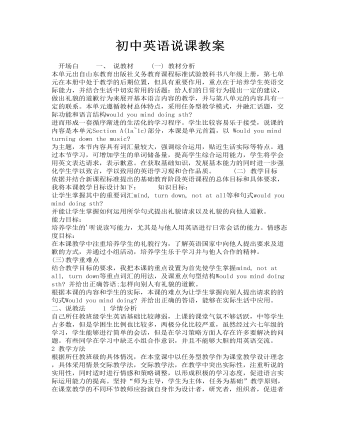
初中英语说课教案
(二) 教学目标 依据并结合新课程标准提出的基础教育阶段英语课程的总体目标和具体要求,我将本课教学目标设计如下: 知识目标: 让学生掌握其中的重要词汇mind, turn down, not at all等和句式would you mind doing sth? 并能让学生掌握如何运用所学句式提出礼貌请求以及礼貌的向他人道歉。

新人教版高中英语选修2Unit 3 Food and Culture-Reading and thinking教学设计
The discourse explores the link between food and culture from a foreign’s perspective and it records some authentic Chinese food and illustrates the cultural meaning, gerography features and historic tradition that the food reflects. It is aimed to lead students to understand and think about the connection between food and culture. While teaching, the teacher should instruct students to find out the writing order and the writer’s experieces and feelings towards Chinese food and culture.1.Guide the students to read the text, sort out the information and dig out the topic.2.Understand the cultural connotation, regional characteristics and historical tradition of Chinese cuisine3.Understand and explore the relationship between food and people's personality4.Guide the students to use the cohesive words in the text5.Lead students to accurately grasp the real meaning of the information and improve the overall understanding ability by understanding the implied meaning behind the text.1. Enable the Ss to understand the structure and the writing style of the passage well.2. Lead the Ss to understand and think further about the connection between food and geography and local character traits.Step1: Prediction before reading. Before you read, look at the title, and the picture. What do you think this article is about?keys:It is about various culture and cuisine about a place or some countries.
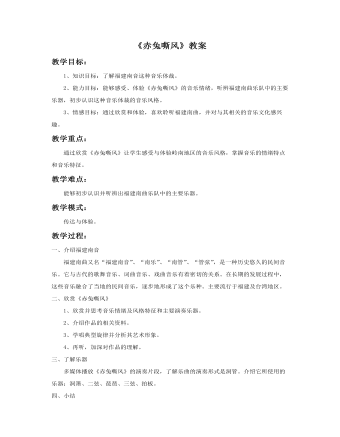
《赤兔嘶风》教案
一、介绍福建南音福建南曲又名“福建南音”、“南乐”、“南管”、“管弦”,是一种历史悠久的民间音乐。它与古代的歌舞音乐、词曲音乐、戏曲音乐有着密切的关系。在长期的发展过程中,这些音乐融合了当地的民间音乐,逐步地形成了这个乐种。主要流行于福建及台湾地区。二、欣赏《赤兔嘶风》1、欣赏并思考音乐情绪及风格特征和主要演奏乐器。2、介绍作品的相关资料。3、学唱典型旋律并分析其艺术形象。4、再听,加深对作品的理解。三、了解乐器多媒体播放《赤兔嘶风》的演奏片段,了解乐曲的演奏形式是洞管。介绍它所使用的乐器:洞箫、二弦、琵琶、三弦、拍板。
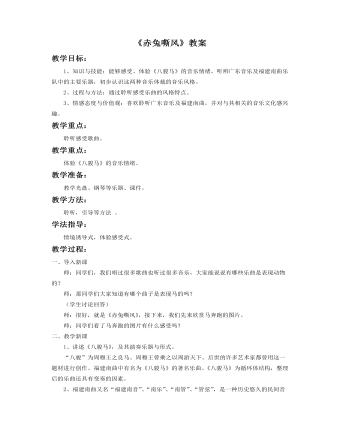
《赤兔嘶风》教案
一、导入新课师:同学们,我们唱过很多歌曲也听过很多音乐,大家能说说有哪些乐曲是表现动物的?师:那同学们大家知道有哪个曲子是表现马的吗?(学生讨论回答)师:很好,就是《赤兔嘶风》,接下来,我们先来欣赏马奔跑的图片。师:同学们看了马奔跑的图片有什么感受吗?二、教学新课1、讲述《八骏马》,及其演奏乐器与形式。 “八骏”为周穆王之良马。周穆王曾乘之以周游天下。后世的许多艺术家都曾用这一题材进行创作。福建南曲中有名为《八骏马》的著名乐曲。《八骏马》为循环体结构,整理后的乐曲还具有变奏的因素。2、福建南曲又名“福建南音”、“南乐”、“南管”、“管弦”,是一种历史悠久的民间音乐。它与古代的歌舞音乐、词曲音乐、戏曲音乐有着密切的关系。在长期的发展过程中,这些音乐融合了当地的民间音乐,逐步地形成了这个乐种。南曲包括了“指”、“谱”、“曲”三大部分。“指”是一种套曲;“谱”是有标题的器乐套曲;“曲”是有唱词的散曲,只唱不说。南曲的演奏形式有“上四管”、“下四管”之分。上四管以洞箫为主,叫做“洞管”;以笛子为主的叫做“品管”。
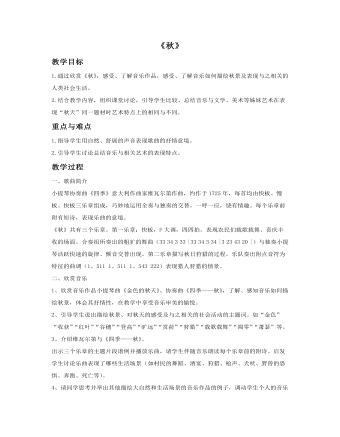
《秋》教案
欣赏音乐1、欣赏音乐作品小提琴曲《金色的秋天》、协奏曲《四季——秋》,了解、感知音乐如何描绘秋景,体会其抒情性,在教学中享受音乐审美的愉悦。2、引导学生说出描绘秋景、对秋天的感受及与之相关的社会活动的主题词。如“金色”“收获”“红叶”“谷穗”“登高”“旷远”“赏荷”“狩猎”“载歌载舞”“凋零”“萧瑟”等。3、介绍维瓦尔第与《四季——秋》。出示三个乐章的主题片段谱例并播放乐曲,请学生伴随音乐朗读每个乐章前的附诗。启发学生讨论乐曲表现了哪些生活场景(如村民的舞蹈、酒宴、狩猎、枪声、犬吠、野兽的恐惧、奔跑、死亡等)。4、请同学思考并举出其他描绘大自然和生活场景的音乐作品的例子,调动学生个人的音乐经验,引发其对于音乐具有描绘性功能的认识和兴趣。
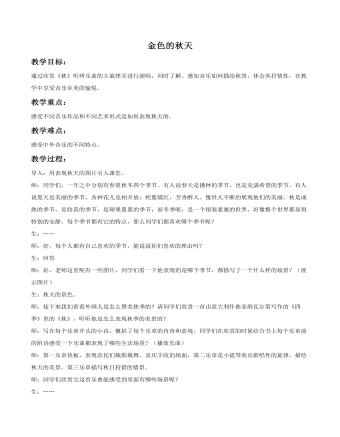
《秋》教案
导入:用表现秋天的图片引入课堂。师:同学们,一年之中分别有春夏秋冬四个季节。有人说春天是播种的季节,也是充满希望的季节,有人说夏天是美丽的季节。各种花儿竞相开放:姹紫嫣红,芳香醉人。像世人不断的展现他们的美丽,秋是成熟的季节,是收获的季节,是硕果累累的季节,而冬季呢,是一个银装素裹的世界,好像整个世界都显得特别的安静。每个季节都有它的特点,那么同学们都喜欢哪个季节呢?生:……师:好,每个人都有自己喜欢的季节,能说说你们喜欢的理由吗?生:回答师:好,老师这里呢有一些图片,同学们看一下他表现的是哪个季节,都描写了一个什么样的场景?(展示图片)生:秋天的景色。师:接下来我们看看外国人是怎么赞美秋季的?请同学们欣赏一首由意大利作曲家维瓦尔第写作的《四季》里的《秋》,听听他是怎么表现秋季的美景的?师:写在每个乐章开头的小诗,概括了每个乐章的内容和意境。同学们在欣赏的时候结合书上每个乐章前的附诗感受一下乐曲都表现了哪些生活场景?(播放乐曲)师:第一乐章快板,表现农民们载歌载舞、喜庆丰收的场面,第二乐章是小提琴奏出歌唱性的旋律,描绘秋天的美景。第三乐章描写秋日狩猎的情景。
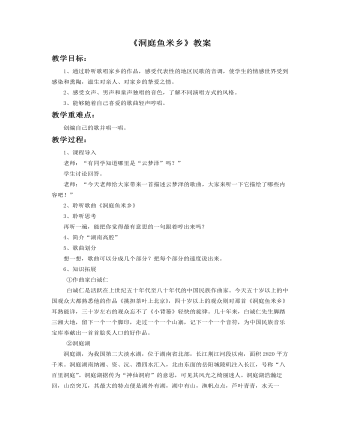
《洞庭鱼米乡》教案
知识拓展①作曲家白诚仁白诚仁是活跃在上世纪五十年代至八十年代的中国民族作曲家。今天五十岁以上的中国观众大都熟悉他的作品《挑担茶叶上北京》,四十岁以上的观众则对那首《洞庭鱼米乡》耳熟能详,三十岁左右的观众忘不了《小背篓》轻快的旋律。几十年来,白诚仁先生脚踏三湘大地,留下一个一个脚印,走过一个一个山寨,记下一个一个音符,为中国民族音乐宝库奉献出一首首脍炙人口的好作品。 ②洞庭湖洞庭湖,为我国第二大淡水湖,位于湖南省北部,长江荆江河段以南,面积2820平方千米。洞庭湖南纳湘、资、沅、澧四水汇入,北由东面的岳阳城陵矶注入长江,号称“八百里洞庭”。洞庭湖据传为“神仙洞府”的意思,可见其风光之绮丽迷人。洞庭湖浩瀚迂回,山峦突兀,其最大的特点便是湖外有湖,湖中有山,渔帆点点,芦叶青青,水天一色。
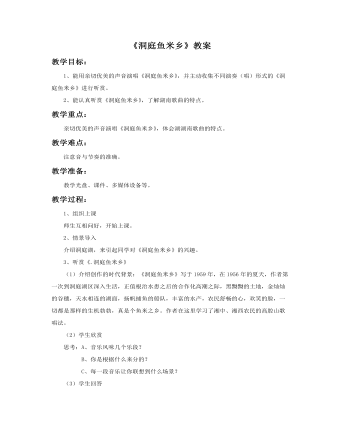
《洞庭鱼米乡》教案
教学过程:1、组织上课师生互相问好,开始上课。2、情景导入介绍洞庭湖,来引起同学对《洞庭鱼米乡》的兴趣。3、听赏《.洞庭鱼米乡》(1)介绍创作的时代背景:《洞庭鱼米乡》写于1959年,在1956年的夏天,作者第一次到洞庭湖区深入生活,正值根治水患之后的合作化高潮之际,黑黝黝的土地,金灿灿的谷穗,天水相连的湖面,扬帆捕鱼的船队,丰富的水产,农民舒畅的心,欢笑的脸,一切都是那样的生机勃勃,真是个鱼米之乡。作者在这里学习了湘中、湘西农民的高腔山歌唱法。(2)学生欣赏思考:A、音乐风味几个乐段?B、你是根据什么来分的?C、每一段音乐让你联想到什么场景?(3)学生回答
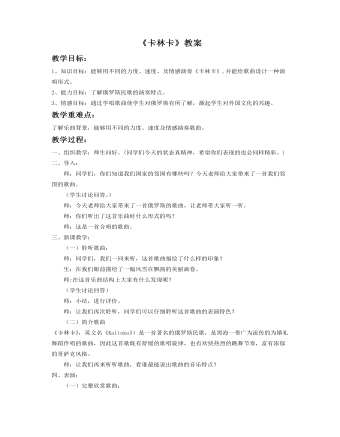
《卡林卡》教案
教学过程:一、组织教学:师生问好。(同学们今天的状态真精神,希望你们表现的也会同样精彩。)二、导入:师:同学们,你们知道我们国家的邻国有哪些吗?今天老师给大家带来了一首我们邻国的歌曲。(学生讨论回答。)师:今天老师给大家带来了一首俄罗斯的歌曲,让老师带大家听一听。师:你们听出了这首乐曲时什么形式的吗? 师:这是一首合唱的歌曲。三、新课教学: (一)聆听歌曲: 师:同学们,我们一同来听,这首歌曲描绘了什么样的印象? 生:在我们眼前描绘了一幅风雪在飘扬的美丽画卷。师:在这首乐曲结构上大家有什么发现呢?(学生讨论回答) 师:小结,进行评价。 师:让我们再次聆听,同学们可以仔细聆听这首歌曲的表演特色?
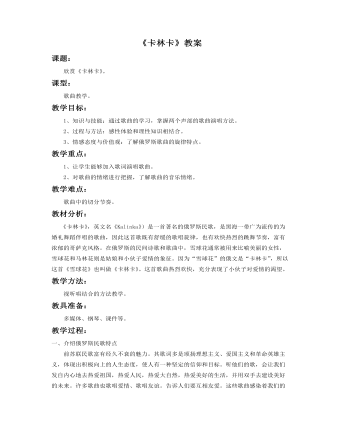
《卡林卡》教案
教学重点:1、让学生能够加入歌词演唱歌曲。2、对歌曲的情绪进行把握,了解歌曲的音乐情绪。教学难点:歌曲中的切分节奏。教材分析:《卡林卡》,英文名《Kalinka》)是一首著名的俄罗斯民歌,是黑海一带广为流传的为婚礼舞蹈伴唱的歌曲,因此这首歌既有舒缓的歌唱旋律,也有欢快热烈的跳舞节奏,富有浓郁的哥萨克风格。在俄罗斯的民间诗歌和歌曲中,雪球花通常被用来比喻美丽的女性,雪球花和马林花则是姑娘和小伙子爱情的象征。因为“雪球花”的俄文是“卡林卡”,所以这首《雪球花》也叫做《卡林卡》。这首歌曲热烈欢快,充分表现了小伙子对爱情的渴望。
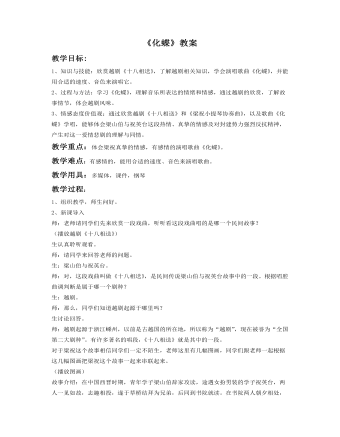
《化蝶》教案
故事介绍:在中国西晋时期,青年学子梁山伯辞家攻读,途遇女扮男装的学子祝英台,两人一见如故,志趣相投,遂于草桥结拜为兄弟,后同到书院就读。在书院两人朝夕相处,感情日深。三年后,英台返家,山伯十八里相送,二人依依惜别。山伯经师母指点,带上英台留下的蝴蝶玉扇坠到祝家求婚遭拒绝,回家后悲愤交加,一病不起,不治身亡。英台闻山伯为己而死,悲痛欲绝。不久,马家前来迎娶,英台被迫含愤上轿。行至山伯墓前,英台执意下轿,哭拜亡灵,此时雷鸣电闪,坟墓爆裂,英台翩然跃入坟中,墓复合拢,风停雨霁,彩虹高悬,梁祝化为蝴蝶,在人间翩翩飞舞。今天,我们就要来学习这首优美的歌曲《化蝶》。
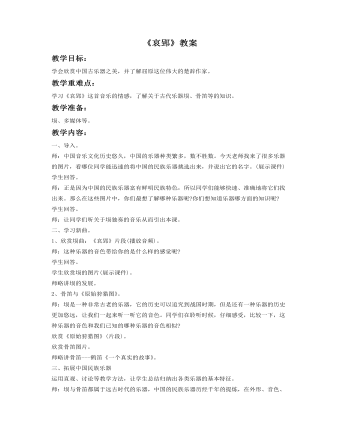
《哀郢》教案
教学内容:一、导入。师:中国音乐文化历史悠久,中国的乐器种类繁多,数不胜数。今天老师找来了很多乐器的图片,看哪位同学能迅速的将中国的民族乐器挑选出来,并说出它的名字。(展示课件)学生回答。师:正是因为中国的民族乐器富有鲜明民族特色,所以同学们能够快速、准确地将它们找出来。那么在这些图片中,你们最想了解哪种乐器呢?你们想知道乐器哪方面的知识呢?学生回答。师:让同学们听关于埙独奏的音乐从而引出本课。二、学习新曲。1、欣赏埙曲:《哀郢》片段(播放音频)。师:这种乐器的音色带给你的是什么样的感觉呢?学生回答。学生欣赏埙的图片(展示课件)。师略讲埙的发展。2、骨笛与《原始狩猎图》。师:埙是一种非常古老的乐器,它的历史可以追究到战国时期,但是还有一种乐器的历史更加悠远,让我们一起来听一听它的音色。同学们在聆听时候,仔细感受,比较一下,这种乐器的音色和我们已知的哪种乐器的音色相似?

《化蝶》教案
这是一部以广泛流传的民间故事《梁山伯与祝英台》为题材,以越剧音乐为素材而写成的单乐章小提琴协奏曲。如今已列入世界名曲,Butterfly-loves(《蝴蝶的爱情》)。小提琴协奏曲《梁山伯与祝英台》由何占豪、陈钢作曲。1959年写成并首演。当时作者是上海音乐学院的青年学生。他们为了探索交响音乐的民族化,选择了这一家喻户晓的民间传说为题材,吸取了越剧中的曲调为素材,成功地创作了这部单乐章、带标题的小提琴协奏曲。《梁山伯与祝英台》描述了梁、祝二人的真挚爱情,对封建礼教进行了愤怒的控诉与鞭笞,反映了人民反封建的思想感情及对这一爱情悲剧的深切同情。乐曲运用西洋协奏曲中的奏鸣曲式,很好地表现了戏剧性的矛盾冲突。并吸收了我国戏曲中丰富的表现手法,使之既有交响性又有民族特色。
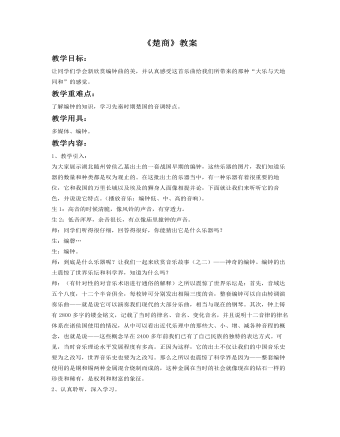
《楚商》教案
之所以震惊了世界乐坛是:首先,音域达五个八度,十二个半音俱全,每枚钟可分别发出相隔三度的音,整套编钟可以自由转调演奏乐曲——就是说它可以演奏我们现代的大部分乐曲,相当与现在的钢琴。其次,钟上铸有2800多字的镂金铭文,记载了当时的律名、音名、变化音名,并且说明十二音律的律名体系在诸侯国使用的情况,从中可以看出近代乐理中的那些大、小、增、减各种音程的概念,也就是说——这些概念早在2400多年前我们已有了自己民族的独特的表达方式。可见,当时音乐理论水平发展程度有多高。正因为这样,它的出土不仅让我们的中国音乐史要为之改写,世界音乐史也要为之改写。那么之所以也震惊了科学界是因为——整套编钟使用的是铜和锡两种金属混合烧制而成的,这种金属在当时的社会就像现在的钻石一样的珍贵和稀有,是权利和财富的象征。